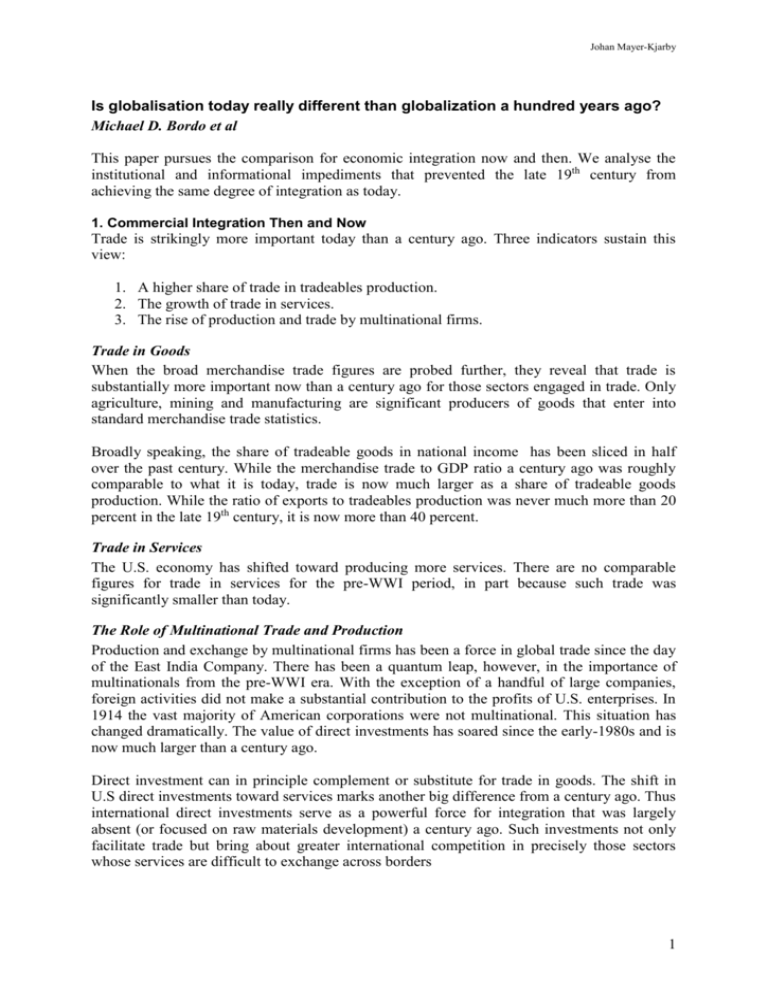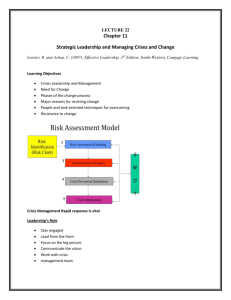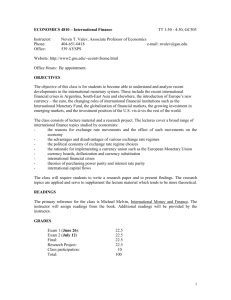Is globalisation today really different than globalization a
advertisement

Johan Mayer-Kjarby Is globalisation today really different than globalization a hundred years ago? Michael D. Bordo et al This paper pursues the comparison for economic integration now and then. We analyse the institutional and informational impediments that prevented the late 19th century from achieving the same degree of integration as today. 1. Commercial Integration Then and Now Trade is strikingly more important today than a century ago. Three indicators sustain this view: 1. A higher share of trade in tradeables production. 2. The growth of trade in services. 3. The rise of production and trade by multinational firms. Trade in Goods When the broad merchandise trade figures are probed further, they reveal that trade is substantially more important now than a century ago for those sectors engaged in trade. Only agriculture, mining and manufacturing are significant producers of goods that enter into standard merchandise trade statistics. Broadly speaking, the share of tradeable goods in national income has been sliced in half over the past century. While the merchandise trade to GDP ratio a century ago was roughly comparable to what it is today, trade is now much larger as a share of tradeable goods production. While the ratio of exports to tradeables production was never much more than 20 percent in the late 19th century, it is now more than 40 percent. Trade in Services The U.S. economy has shifted toward producing more services. There are no comparable figures for trade in services for the pre-WWI period, in part because such trade was significantly smaller than today. The Role of Multinational Trade and Production Production and exchange by multinational firms has been a force in global trade since the day of the East India Company. There has been a quantum leap, however, in the importance of multinationals from the pre-WWI era. With the exception of a handful of large companies, foreign activities did not make a substantial contribution to the profits of U.S. enterprises. In 1914 the vast majority of American corporations were not multinational. This situation has changed dramatically. The value of direct investments has soared since the early-1980s and is now much larger than a century ago. Direct investment can in principle complement or substitute for trade in goods. The shift in U.S direct investments toward services marks another big difference from a century ago. Thus international direct investments serve as a powerful force for integration that was largely absent (or focused on raw materials development) a century ago. Such investments not only facilitate trade but bring about greater international competition in precisely those sectors whose services are difficult to exchange across borders 1 Johan Mayer-Kjarby 2. Why is Commercial Integration Greater Today? Why is trade relative to the production of merchandise goods so much greater than a century ago? The simple answer is that the barriers that inhibit trade are lower today than a century ago. Transport Costs Even if transport costs have not fallen as dramatically as they did in the late 19th century they have remained low. In addition technological changes have expanded the array of delivery mechanisms and cut the time to delivery in ways that have brought an ever increasing variety of goods (cut flowers from Central America, lobsters from Maine) into world commerce. Trade Barriers Evidence on tariff barriers indicate that these have been dramatically reduced. All the commodity market integration in the Atlantic economy after the 1860s was due to the fall in transport costs between markets, and none was due to more liberal trade policy. In the 1950 these barriers where still in the 20 percent range- Multilateral trade negotiations such as GATT has since helped reduce tariffs to under 5 percent. Broadly speaking trade barriers have fallen substantially in the post-war period and are quite likely lower today compared to a century ago. Informational Barriers to Exchange In addition to transportation costs and trade barriers, informational barriers to exchange can limit the extent of market integration. Consumers are likely to have better information about the attributes of goods produced locally, while producers are likely to have better information about local tastes and demands. A century ago, before the age of mass communications the difficulty of transmitting information about these attributes was plausibly greater than today. 3. Containing Trade Tensions As trade expanded in the years leading up to WWI, aggrieved interests sought redress. This manifested itself in increased political pressure to raise trade barriers, halt immigration and stifle capital flows. Could the current wave of globalisation generate similar pressures to retreat from the global economy? Or do we now have institutional safeguards that can relive such anti globalisation pressures and preserve political support for an open world economy? We suggest three reasons why trade tensions were greater despite the fact that the extent of product-market integration was, if anything, less. Macroeconomic Performance First, macroeconomic performance – both growth and stability – is important to maintaining support for an open trade regime. Up to the outbreak of WWI, protectionist pressures were most pronounced during the “Great Depression” of the 1879s. Indeed, in the 15 years or so preceding the outbreak of war, there was little resurgence of protectionism. One factor that contributed to this outcome was the world-wide economic boom from the mid-1890s up to WWI. The lesson is trite but true: while global integration undoubtedly creates sectoral pressures, those pressures are muted in an environment of steady economic growth and low unemployment. 2 Johan Mayer-Kjarby Social Insurance Second, there were few forms of social insurance in place a century ago to mitigate the effects of surges in import competition. Workers seeking compensation from foreign competition thus had no choice but to lobby Congress for higher tariffs. The existence of escape clause provisions in trade agreements have been necessary to maintain political support for an open world trading system. Experience shows that such measures may help deflect protectionist measures. The Growth of Countervailing Interests Finally, while increased integration can threaten the economic interests of certain groups, it also creates groups whose interests are enhanced. For example, steel-using firms have successfully fought off efforts by the steel producers to obtain extended protection, and semiconductor –using firms have fought off efforts by semiconductor producers. Summary Stable macroeconomic management, the existence of escape clauses and the rise of pro-trade economic interests have been capable of sustaining political support for an open trading system. 4. Financial Integration Then and Now Even though net capital flows where large relative to GDP before 1913 the range of sectors and activities to which this foreign investment was directed was narrower than today. In the overseas regions of recent settlement to which the bulk of European lending flowed, external resources were invested in infrastructure projects which enhanced the borrowing country’s capacity to export. Foreign funds were used to construct port facilities, railway networks and other internal improvements. At the same time, the lending countries provided open markets for the raw materials and agricultural commodities produced and exported by these newly settled regions. What is clear is that foreign borrowing meant almost exclusively borrowing by railways and borrowing by governments. Less information exists on the volume of short-term capital flows prior to 1914, but everything we know points to a lower level than today. Short-term flows were significantly smaller than long-term flows, in sharp contrast to today. 5. Why is Financial Integration Greater Today? The differences in the scope of market integration were consequences of information asymmetries, contracting problems , and macroeconomic risk that limited the extent of capital and commodity flows prior to 1913 and that continue to limit them, albeit to a lesser extent, today. By information problems we mean the difficulty of determining product, project and borrower quality. By contracting problems we mean difficulties of detecting fraud and of attaching collateral. By macroeconomic risks we mean mainly exchange risk. 3 Johan Mayer-Kjarby Information Problems The transatlantic cable was laid in the 1860s. Prior to its opening, it could take as long as three weeks for information to travel from New York to London. The radio telephone was the next breakthrough. Long-term lending to manufacturing, commercial and financial concerns was deterred not so much by the limitations of the communications technology as by the difficulty of assembling and evaluating the information to be communicated. Overseas investors were further deterred by the difficulty of monitoring and controlling management’s action ex post. For example, asymmetric information can explain the disproportionate share of railway bonds in foreign investment portfolios. It was relatively easy to monitor the actions of railway company’s management: investors could verify how much track had been laid more easily than they could verify and evaluate the investment decisions of management in other sectors. Information asymmetric can explain the disproportionate importance of family groups, rating agencies, development of investments trusts (mutual funds), the growth of insurance companies and the popularity of specialised publications. Finally information asymmetries can explain the surprisingly limited importance of foreign direct investments prior to 1914 and the importance of the free standing company as the vehicle for foreign direct investment. Contracting Problems Information problems were, in our view, the key explanation for the relatively limited scope of late 19th century capital flows. But they were not the entire story. Beyond the immediate problem of geographical distance, it also made for problems of control. It was hard to monitor actions taken by management when a round-trip communication could take a month. Foreign investors were also deterred by the uncertain legal security of their claims. Some states prohibited foreigners from serving as directors of the corporations chartered there. In response, some British investors hired American citizens to represent them on the board, but this extra layer added principal-agent slack. Foreign investors also had reason to fear that they would not be treated fairly under American bankruptcy law. They worried that companies might be wound up and their assets sold off to other claimants. Thus, America’s experience before 1914 points up the importance for emerging markets seeking to attract foreign investment of transparent and equitable bankruptcy laws. Direct investment through free standing companies was one solution to minimising contracting problems. British shareholders could be confident of their rights because the free standing company was subject to British law. 4 Johan Mayer-Kjarby Macroeconomic Risks A number of observers emphasise exchange risk, unstable and uncertain monetary and fiscal policies and political risk factors limiting pre-1913 international investment flows. British investors viewed securities issued by countries not on the gold standard as riskier than those of countries that were. In case of government bonds the fear was that governments off gold would live beyond their means. The Absence of Adequate Accounting Standards While difficulties of contract enforcement and macroeconomic risks were significant deterrents to foreign investment, we have argued that asymmetric information was the overwhelming important obstacle to international capital flows. And these information problems were compounded by the inadequacy of prevailing auditing and accounting standards. The use of auditing and accounting principles first became prominent in the railways were scale was large and co-ordination were of the essence. But overall the accounting practices of most 19th century enterprises were rudimentary. British investors demanded that railway issue regular financial statements prepared by British chartered accountants. British accountants set up practice in America from the mid-19th century. These British accountants played a key role in the formation of the American Association of Public Accountants. In 1894 a uniform accounting standard for railroads was established. And in 1896 a general accounting standard was adopted. Two inter-war developments sealed the emergence of standardised accounting principles. One was the advent of the corporate and individual income tax. The other was the collapse of the stock market in 1929 precipitated by the crash of Ivar Krueger’s empire who had deceived the public about his companies’ financial condition. Thus, the United States’ own experience suggest that both market discipline1 and government intervention are needed to yield the desired result. International investors can be an important source of that market discipline, and international accounting firms can be efficient agents of technology and knowledge transfer. But until that transfer is effected, the integration of the domestic and foreign markets will remain incomplete. 6. Financial Crises The important questions are what caused the banking currency problems and how serious were their economic consequences. While there are similarities between the “emerging market crises” of the Victorian Age and recent events a key difference is the monetary regime. The earlier crises occurred under the fixed gold standard exchange rates, while the recent crises occurred in a regime of managed flexibility. This has several important consequences: Market discipline – the reluctance of markets to lend to a country where accounting principles were not followed. 1 5 Johan Mayer-Kjarby First, whereas the gold standard quickly transmitted crises between peripheral and core countries, today the advanced countries are better insulated from shocks. Central banks have more room to manoeuvre not being constrained by the gold price. Second, and working in the other direction, credible adherence to the gold standard -- in the sense that maintaining the gold parity would be the primary policy goal and, if it had to be abandoned, it would be restored at the original parity -- ensured capital flows would be stabilising once resolution was underway. Another key difference affecting the resolution of crises is that the peripheral countries neither possessed domestic lenders of last resort nor were the beneficiaries of international rescue loans. Well before 1914 the core countries had developed reasonably effective lenders of last resort and a system of international financial co-operation. Evidence on the Severity and Longevity of Crises Effects A key fact emerging from studying the effects of banking and financial crises is that the output effects were somewhat less serious before 1914 compared to today. This holds for banking crises, currency crises and twin crises alike. Thus, output declined less in the pre1914 crises. Post-crisis recovery The recovery from currency crises where quicker prior to 1914. The recovery both began earlier and continued more rapidly prior to 1914. Prior to 1914, countries driven off the gold standard generally intended to restore the previous exchange rate once the crisis had passed. Hence investors that suffered losses when the currency collapsed anticipated gains as the currency recovered to its traditional parity. Hence, devaluation did not unleash persisten capital flight. Rather, gold and capital began flowing back in at a relatively early date, stabilising the economy and stimulating recovery. In contrast the recovery from banking crises starts earlier in the modern period. A likely explanation is the absence of an effective lender of last resort at the periphery in the pre-1914 era. (Automatic stabilisers were also absent prior to 1914.) A final point is that there were no international rescue packages available to emerging economies prior to 1914 whereas such rescues are a prominent feature of the international financial landscape today. Thus while the crisis problem is hardly new there are some new and distinctive features of recent crises. The drop in output following their outbreak is even more dramatic. And for currency crises, the subsequent recovery is slower. In this respect as others, there are aspects of our current globalisation that are unprecedented. 7. Conclusion We have sought in this paper to emphasise a small number of general points. First, the globalisation of commodity and financial markets is historically unprecedented. 6 Johan Mayer-Kjarby Second, the advent of highly integrated commodity and financial markets has been accompanied by tensions. This was also the case before 1914. The surprise is that these problems are not even more severe today, given that the extent of integration is so much greater today. One possibility is the stabilising role of the institutions built in the interim. At the national level this means social and financial safety nets. At the international level it means the WTO, IMF and other institutions and agreements. Another explanation for the contrast is that the simple maturation of markets over time made it easier to live with globalisation. The development of better auditing and accounting practices at the national level has made it easier to apply those same practices to international transactions, with stabilising consequences. 7






